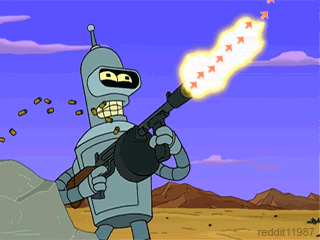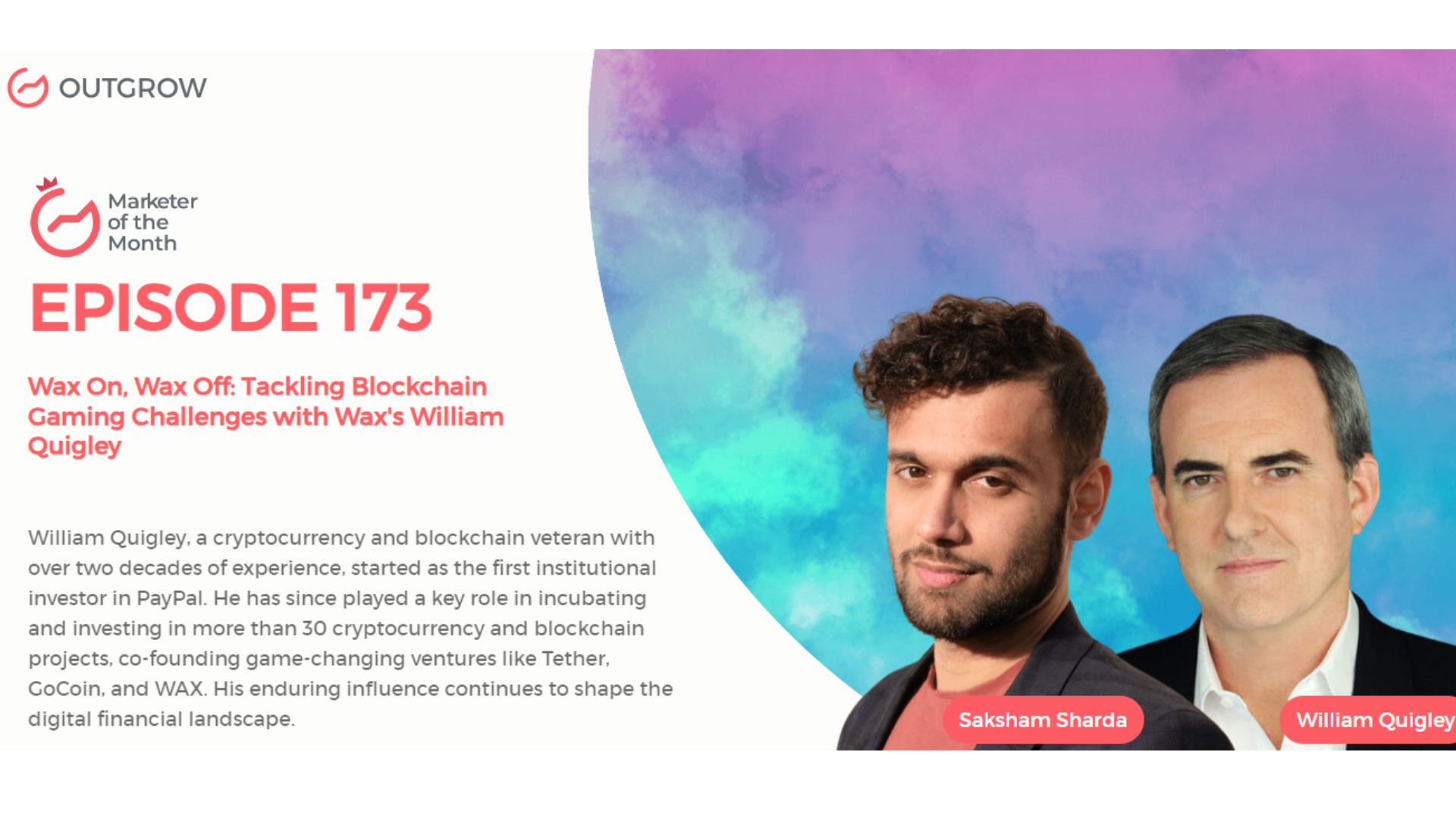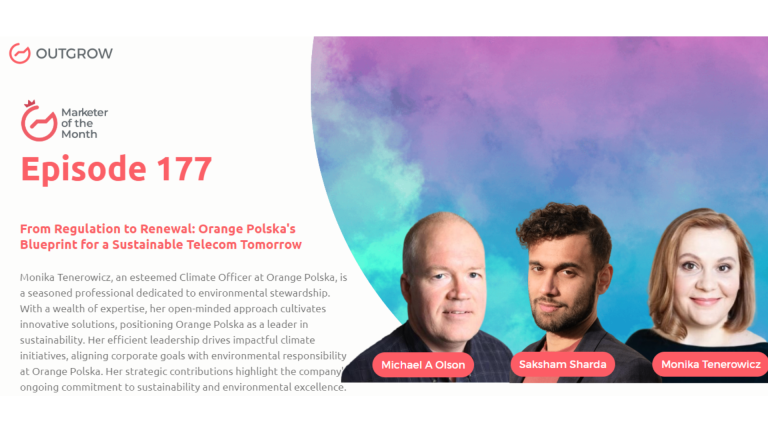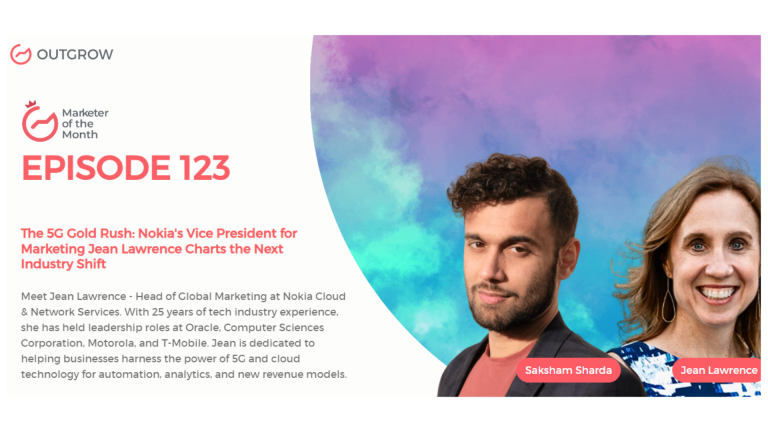Hey there! Welcome to the Marketer Of The Month blog!
We recently interviewed William Quigley for our monthly podcast – ‘Marketer of the Month’! We had some amazing insightful conversations with William and here’s what we discussed about-
1. Early Exposure to Virtual Item Trading: Partner’s concept of trading virtual items for real money.
2. Delegated Proof of Stake Mechanism: Application to video game virtual item trading.
3. Video Games as Technology Pioneers: Pushing boundaries with graphics and augmented reality.
4. Tackling Blockchain Gaming Challenges: Creation of Wax as a purpose-built blockchain for media files.
5. Sustainable Blockchain: Adoption of proof-of-stake to address energy consumption.
6. Future of NFTs: NFTs as mini-computers with endless possibilities.
About our host:
Dr. Saksham Sharda is the Chief Information Officer at Outgrow.co. He specializes in data collection, analysis, filtering, and transfer by means of widgets and applets. Interactive, cultural, and trending widgets designed by him have been featured on TrendHunter, Alibaba, ProductHunt, New York Marketing Association, FactoryBerlin, Digimarcon Silicon Valley, and at The European Affiliate Summit.
About our guest:
William Quigley, a cryptocurrency and blockchain veteran with over two decades of experience, started as the first institutional investor in PayPal. He has since played a key role in incubating and investing in more than 30 cryptocurrency and blockchain projects, co-founding game-changing ventures like Tether, GoCoin, and WAX. His enduring influence continues to shape the digital financial landscape.
EPISODE 173: Wax On, Wax Off: Tackling Blockchain Gaming Challenges with Wax’s William Quigley
Table of Contents
The Intro!
Saksham Sharda: Hi, everyone. Welcome to another episode of Outgrow’s Marketer of the Month. I’m your host, Dr. Saksham Sharda, and I’m the creative director at Outgrow. co. And for this month we are going to interview William Quigley, who is the Co-founder of Wax and Tether.
William Quigley: Great to be here. Thank you.
Don’t have time to read? No problem, just watch the Podcast!
Or you can just listen to it on Spotify!
The Rapid Fire Round!

Saksham Sharda: Alright, so we’re just gonna get right into it. The first question of the rapid-fire is, at what age do you want to retire?
William Quigley: At what age do I want to retire? Right before I expire.
Saksham Sharda: how long does it take you to get ready in the mornings?
William Quigley: Not too long. I work out in the morning and then I get ready. So I don’t have a lot of hair. 10 minutes.
Saksham Sharda: Most embarrassing moment of your life.
William Quigley: Mm, that’s a pass. Too many
Saksham Sharda: Favorite color.
William Quigley: Green.
Saksham Sharda: What time of day are you most inspired?
William Quigley: Mornings. Early mornings.
Saksham Sharda: How many hours of sleep can you survive on?
William Quigley: I like at least seven.
Saksham Sharda: Fill in the blank. An upcoming NFT trend is ____.
William Quigley: Using NFTs as a way to message large communities within an established brand.
Saksham Sharda: The city in which the best kiss of your life happened.
William Quigley: Los Angeles.
Saksham Sharda: Pick one. Mark Zuckerberg or Elon Musk.
William Quigley: Elon.
Saksham Sharda: The biggest mistake of your career?
William Quigley: Biggest mistake of my career. I mean, I guess what I would say is, for the biggest mistake of my career, I’m a venture capitalist. We make mistakes every single day. The vast majority of the investments we invest in fail. So lots of deals I looked at, I didn’t understand, went on to become big, attractive companies. So there’s that.
Saksham Sharda: How do you relax?
William Quigley: I like playing video games.
Saksham Sharda: How many cups of coffee do you drink per day?
William Quigley: One.
Saksham Sharda: A habit of yours that you hate.
William Quigley: Morning exercise, even when it’s raining.
Saksham Sharda: The most valuable skill you’ve learned in life.
William Quigley: To examine the assumptions behind why I am doing something.
Saksham Sharda: Your favorite Netflix show?
William Quigley: Thader.
Saksham Sharda: The last movie you saw that was memorable.
William Quigley: James Bond.
Saksham Sharda: The last song you’ve been listening to that you like.
William Quigley: Something from Rufus.This whole.
Saksham Sharda: Alright, that was the end of the rapid-fire round. Now you can choose to elaborate on any one question that you felt you wanted to say more about, or we can go onto the bigger question.
William Quigley: Yeah, we can go on.
The Big Questions!

Saksham Sharda: Okay. So the first one is, can you share the story behind your journey as a co-founder of Wax and how you became involved in the world of blockchain technology and video game virtual items?
William Quigley: Sure. So how did I get involved in crypto overall and then launch Wax? The real brief version of it is this. There was a world of virtual item trading that predates crypto by a long, long time, and that is video game virtual items. So I worked with my partner who invented the concept back in the nineties of trading video game virtual items for real money. The first game he did that on was a game called Ultima Online, which was a big game and the first really popular game in the West that allowed you to trade virtual items back and forth. It’s not well known, but a lot of the early people who were embracing and trading cryptocurrencies were video game virtual item traders. So my partner had been running an exchange. I was on his board for trading video game virtual items. He sold that and about a year later he read about Bitcoin, read the white paper, and started the mine. And it took multiple times for him to convince me that that bitcoin, which is pretty much all it was back then, was something I should be serious about. But eventually, I did. I was actually in Singapore helping a friend of mine open up her video game virtual item marketplace. And she was driving me back to the airport. She said, what do you think of Bitcoin? And I thought, wow, you know what? That’s the nudge I need to get educated. I went back to the US. My partner said, let me give you a couple of hours of pitch. He did. And that was it. From that point on, I thought, now I get it. Because he helped me understand why blockchain and tokenization were super important. I think even to this day, most crypto people don’t understand the difference between digitization and tokenization. Tokenization you can only do on a blockchain. So it was after really right around a little bit after Tether where my partner and I were thinking, Hey, what if we started to trade video game virtual items, and skins using blockchains? The problem with video, virtual item trading is that video game companies never liked it. And they were always trying to shut it down, restricting their ability to do it. Anyone in video gaming knows this. So we thought if we moved this stuff to blockchain trading among people would be embraced. It wouldn’t be something you’d have to stop. And finally, in 2017, something happened that allowed us to do that, which was a guy named Dan Larimer, who I think has created more valuable blockchains than anyone else. I think he’s created $4 billion blockchains. He came up with a concept of delegated proof of stake as a consensus mechanism for a blockchain that to us seemed like a mechanism we could use to get the trading volume, the transaction volume at a low cost and a high enough transaction volume that we could do skins or video game virtual items. And it turned out to be true to this day. I don’t think the delegated proof of stake consensus mechanism approach has any peer certainly better than let’s say, the proof of stake system that Ethereum is using and almost any other. So that’s how I got from, well now blockchain to where we are today.
Saksham Sharda: What other technologies or paradigm shifts are video games at the forefront of?
William Quigley: So video games have I think they’re well known now for having ushered in the mass market adoption of a lot of different technologies. Video game companies are always pushing the envelope on what they’re trying to do, whether it’s with graphics or with mm OGs, so massively multiplayer online gaming experiences are really what Metaverse is hoping to be one day. The next area where video games will probably push something is gonna be in the form of augmented reality. You saw a little bit of this when NTA created the Pokemon craze where you had this first attempt at augmented reality among consumers or game players. So I don’t think the new Apple goggles are going to be well embraced. The price point, of course, is a very, very expensive and big barrier to entry for consumers at 3,500 us. But also people don’t like wearing things on their faces for long periods. But whatever drives, and I don’t know what that’s gonna be, it’s a mass market technology that allows people to have a wearable, easy-to-use, long battery life, none-like heavy pieces of equipment for people to experience augmented reality. The first place that’s going to get the uptake is gonna be in some video games. I don’t know what that’s gonna be. I don’t even know what the exact form factor for augmented reality is gonna be, but I know what it’s not gonna be. I learned a long time ago that people don’t like wearing things on their heads for long periods if they don’t have to. So we have to wait until it’s contact lenses or glasses, I think for that to happen. But when it does, gaming will be what drives usage.
Saksham Sharda: And Google Lens also failed. So Google Glasses, sorry. So that wasn’t even as, I assume, as heavy as the app.
William Quigley: Yeah, Google Glasses failed because there was such a chasm between what people hoped for. I thought we were going to be able to put on their glasses and we would see out a few feet from our eyes a screen of some sort. That’s what I thought we were gonna get. Instead, we got something that was almost comical, you know, a little square in your periphery that you could look at that had no good use case to get people to want to use it. So having said that I think the Google Glasses form factor is superior to the goggles that Apples come out with.
Saksham Sharda: So which video games do you think are at the forefront of technological change? Which ones are trying to bring in new technology?
William Quigley: Well, all of the top video games, anything. Let’s say that Val is the guy who created Steam, so think of Fortnite, well, not Fortnite, but CS GO right counterstrike. Think of things like the console, and base games, right? Where there’s massive technology that’s been invested. All of them are pushing graphics. That’s the main dimension that you can push gameplay itself. There’s not a lot of innovation around, there are roughly four or five different popular game mechanics that everybody embraces and it’s getting just the right combinations, right? So, you know, lots of first-person shooter people liked Rainbow Six, they liked CS Go. And then, and then why am I blanking on it? Pub G came along and Pub G was amazing. It was a last-man-standing kind of battle royal game mechanic. I don’t know why, but I loved it and it became super popular. But if you looked at what it was doing, there was nothing in and of itself, that was that different from a lot of other games that came before it. The idea of crates, right? Where you can get a loot box in a game that’s an old mechanic, but still one of the dominant mechanics. All you have to look at is where video game revenues come from. And virtually all of them come from the sale of video game virtual items, you know, $200 billion a year in growth. So it seems like a lot of the same things are what drive people playing the games, but they get just these small elements that are different, you mentioned Fortnite is not that much different between Fortnite and Pug G Right? But for some reason, a lot more people liked Fortnite. So I build video games and I gotta tell you, you never know what’s gonna catch on. You know, it was just when mobile came around, that was a brand new form factor. And of course a bunch of companies that are natively built in mobile. So the game was never available before on PC or console. They learned how to do certain things that work well with the phone. So now you’ve got mobile as a giant category but you still have PC games and console games that are still popular. If it was deterministic, if we knew the formula for making something a hit game, then there’d be a lot more of them. I do know that version 1.0, of Blockchain Video gaming, was a good experiment, but it’s not been successful as judged against the other dominant platforms like mobile or PC browser-based games, or consoles. So we have a lot more work to do for the blockchain-based games to reach that, you know, threshold of popularity.
Saksham Sharda: When did you get into gaming itself, and what got you into games?
William Quigley: So video gaming has had a whole series of or I said gaming Yeah. Of playing games. Yes. And so I existed for thousands of years. So the first games I was playing, cuz I’m old, were games in arcades, you know, arcades dominated in the seventies and the eighties. That’s what we played. And then I started getting excited about them when you could buy things like Trash Eighties, which were Radio Shack-built computers, and you could play simple games on those. And then I went much more than into console-based games. I’m a first-person shooter gaming guy, so my console, I think, had some great ones. And then I started to get pretty excited when game companies came up with this concept of allowing people to trade these digital items within games. That was more the late nineties, so I’d always been playing them. But as anyone in this industry knows, there is sort of a ramp up from, you know, children to people in late teens, early twenties, who play a lot of games, especially guys. And then as you have to earn a living, they drop a lot. And I’m no different from anyone else. My gameplay has dropped a lot as well. I still like first-person shooter games. Those are easier to jump in and jump out. My partner likes RPGs and role-playing games. Never been a fan of those, even though they are probably the most popular games globally, but just not interesting to me. And block Chase-based games I liked because there was a lot around economics and trading that the blockchain games could incorporate. Also with NFTs, which is the primary way blockchain-based games make revenue, you could do cool things with them because you could never take a traditional video game virtual item and make it intelligent. But you can do that with an NFT because it’s a virtual machine. It’s a, it’s a com, it’s a microcomputer. That’s what NFTs are. So you can program them to do a lot of fantastic things. This, by the way, is one of the reasons I would give for why blockchain as a gaming platform has taken longer to take off. There’s a lot more complexity in incorporating gameplay with blockchain because of this need to interact with a smart contract. And while it opens up a lot of possibilities, it also can be a bit overwhelming.
Saksham Sharda: So what are some of the current limitations or obstacles that blockchain technology faces when applied to the gaming industry? And how are you working to address them?
William Quigley: Yeah, so limitations on blockchain-based games, the first is quite obvious. It’s much more complicated than a console game, a mobile game, or a browser-based game. As a result, the adoption has been much slower. When we did Wax, we built Wax. It was the first blockchain purpose-built for media files to be easily transmitted across it. And initially, those were NFTs. And to convince people to first invest in technology, you know, you had to do that with phones. I’m old enough to remember how many years it took for people, the average person, to own a phone. PCs, it took several decades. Blockchain has taken a long time, and maybe it’ll take longer than those two platforms because it is more complicated. So consumers embrace convenience, things that aren’t convenient, they don’t want to do. And that’s our biggest hurdle. With wax, we decided we weren’t just gonna build a blockchain. We were gonna have a marketplace that would allow you to trade items within a game. And we would have a wallet that was native to the wax blockchain, no blockchain layer one had ever done that, where they built all the piece parts. I referred to it more as the Apple model versus the Microsoft model. Microsoft came out with Doss and then Windows and then said, that’s sort of the operating system for the pc. All you vendors build stuff that’s going to be working with those things, but it takes a while to do it and standards aren’t perfect. And so it’s a little janky. We wanted it to be much more seamless. We were the first guys who built a wallet that allowed for O-Auth or the ability for people to log in with their traditional like Google or Facebook password and, and, you know, credentials. So that made it easier to sign up and to use it, but it’s still more of a foreign thing, and that results in fewer people being willing to invest the time to embrace it. And then the other thing that has caused it to take a bit longer is that blockchains are not ideal platforms for everything. I would go as far as to say that a blockchain is the worst way to do most things. It’s not like a SQL database. It’s not like a traditional database that can process things fast. As a result, there’s a delay as transactions have to take time to be confirmed by the distributed blockchain validators. And that slows it down. Games are fast, so having that time lag is another impediment. So what we need is something that a blockchain can do in a game that can’t be done with any other platform. And that’s attractive enough that people say, okay, I’ll do it. For instance, I remember when mobile games first became a thing, I think Jammed Out was the first one I ever saw. And it was like a little you could play bowling on this little Samsung or a Nokia feature phone. It was awful. But it was fun if you had the phone and you could take it everywhere with you. And it was that untethered convenience of a game platform in your pocket. That also was a phone that I think led to people saying, well, it’s kind of a shitty interface, but I always have it on and it’s always with me. So I’ll explore and try out games when I’m, you know, got a minute break between tasks or something. We need something like that for blockchain where we find a mechanic that only blockchains can do that can be integrated within a video game. And then I think we’ll see it take off.
Saksham Sharda: How do you incorporate those aspects into your operations?
William Quigley: So sustainability. Well, first I would say we all know now that proof-of-work blockchains consume a lot of energy and Bitcoin is probably the pre-eminent example of that. Now, not a well-known fact, but the majority of Bitcoin mining is done using renewable energy like solar and other forms of wind. So I think Bitcoin gets a bad rap, but in the past, it did use a lot of energy. So proof of stake on the other hand has no more energy consumption than let’s say an e-commerce site. So when we built wax, we built it to be proof of stake. And therefore I think the energy consumption is equal to, let’s say an e-commerce site. We’re doing a pretty good job there. The other is and I would switch from wax to Tether. Tether allows for, I think, one of the great transfers or recaptures of value from a few privileged firms or people in the world back to humanity. This is because by tokenizing a currency, you allow someone to hold it outside of a bank. And that means they don’t have to convert that currency into their native currency. So if someone in Europe buys something or sells something from someone in the United States and that US person sends them a tether, and that is tokenized US dollars, that person doesn’t have to convert that US dollar into Euros. Now by not having to convert it, by being able to hold it natively as dollars, what do they save? Well, they don’t have the transaction fees that you would normally have if you were using, let’s say, a credit or a debit card. But those fees often pale in comparison to a much bigger tax on global consumers and even businesses. And that is currency conversion costs. So currency conversion costs are the tax you pay when you switch from one currency to another. It’s probably the largest, mostly invisible tax that virtually everyone in every business has to pay and is captured by only a few thousand firms globally. These are firms that have been granted a special privilege by their governments to do currency exchange. And all you have to do is look at the Bible, who are the most hated people in the Bible. It was the currency exchange people who were licensed by the temple to conduct business. So that’s still the case here. The difference is it’s a hidden tax because you never really understand what that currency conversion is costing you. So in a roughly 80 trillion global economy that’s 80 trillion equivalent is produced every year among the nations. There are maybe 25 trillion or so that’s cross-border commerce related, and roughly about 1 trillion out of that 80 trillion economy is taken or captured by a few firms globally for the privilege of converting your currency. So one of the things I would say if the only thing blockchain did if its only contribution was to allow tokenized fiat currency and to allow consumers and businesses globally to no longer have to convert their currencies every time they travel from one place to another, that trillion dollars going back in the hands of the people is gonna be used for something and hopefully used and spent in a better way than the firms who capture it now.
Saksham Sharda: And what are some of the new and exciting things you’re doing with Tether at this point? What is your next horizon?
William Quigley: So we might not want to ask me that question since I’m no longer working with Tether. I like everybody else to use it, but you know, I only focused on media files, you know, Wax, and hopefully helping the gaming industry. Hopefully, the music and, you know, NFTs are a very useful technology, and I’m putting a lot of time into NFTs, but not in the traditional way that we saw the last couple of years.
Saksham Sharda: So have you seen everything that NFTs can do or is there anything new?
William Quigley: So when it comes to NFTs we’ve almost seen nothing that NFTs can do. And, briefly, I want to help people understand what an NFT is. What it’s not is a pretty picture, a snippet of a film, or a snippet of a musician’s performance. Those are applications of NFTs. An NFT is a remarkable piece of technology. It’s a mini-computer that NFT is what we would call a virtual machine, but it’s a mini-computer and a computer that can be transferred between people and programmed to do essentially anything any other computer can be programmed to do. So the first, the first kind of instantiation of it was putting picture pictures or images that could be traded back and forth. And then we put the video on it, music. And I’m quite pleased that we did do that because it introduced not just NFTs, but even blockchains to consumers to finally say, oh, I see what I can do with these. But we haven’t scratched the surface of what I would tell people because it’s like if somebody said, what can you do with software? I think the right answer is, well, I guess it’s only limited by your imagination. Nfts are software, they’re computers, and they can be programmed to do anything. So as a result, what I suspect will happen is as an industry, as businesses start to understand that these are just virtual items, call them emojis that can be programmed to do anything you want them to do, we’re going to see a lot more people, I think virtually every industry on earth will, in the end, incorporate NFTs. They may not call them that, they might have some other word for them, but they’re going to send you tokenized objects. And the difference between a tokenized object, let’s say an NFT, and a digital object like an emoji, is several. One, the digital object can’t be programmed. It’s just a flat file, whereas the tokenized one can as long as it’s talking to a smart contract. But also it has this amazing feature where it’s the only thing I know on earth that has this feature where someone can send something to another person electronically and the recipient of that thing can hold that or receive it and know instantly at virtually no cost and know with certainty that the thing they got is the genuine article. You know, there’s nothing else I know of that has that property. You know, you can’t give somebody gold or what they claim is gold and you know it’s gold. You need to test it. You can’t give them diamonds, you can’t give them an email and say this is the original email. There’s nothing like it. And so the ability to send something digitally or electronically and for them to know it’s not a copy, it’s the original and it’s never been tampered with because one of the beautiful things about a tokenized item is it can’t be edited. You can’t change it. So what they’re getting is the original copy. Now, if you start to educate businesses of the world, governments of the world who issue things like passports or other forms of ID who issue certificates of authenticity, and you can tell them, by the way, the nice thing about this is it can never be counterfeited. Well, their imaginations can start helping them figure out all the things their customers might want that have those properties. By the way, all you have to do is think about one of the most counterfeited things on earth, which is the US $20 bill or a hundred-dollar bill. North Korea makes dollar bills a hundred dollar bills so perfect that even the US Treasury has a hard time figuring ’em out. Well, isn’t it amazing to think that you could tokenize a $20 bill or a hundred dollar bill, and by doing so, putting it in that NFT wrapper, you would know without any effort and at no cost, it was genuine? So think about NFTs in this way. They’re like an envelope that assures whatever is inside it has never been tampered with and is the genuine thing that is the future of NFTs.
Saksham Sharda: Alright, so the last question for you is of a personal kind. What would you be doing in your life, if not this right now?
William Quigley: Well, I have told people for many years now that my focus at the end of my career, cuz I’ve been around a long time is at the intersections of global e-commerce, blockchain, and cross-border trading. So that intersection is where I think blockchains have a ton to add in value and that’s an area where we see some of the fastest growth from an economic standpoint. So this is where I want to be and I don’t think I’ll be jumping into anything else before I eventually retire at some point in the future when I can no longer walk.
Let’s Conclude!
Saksham Sharda: Thanks, everyone for joining us for this month’s episode of Outgrow’s Marketer of the Month. That was William Quigley, who is the Co-founder of Wax and Tether.
William Quigley: Great to be here. Thank you.
Saksham Sharda: Check out the website for more details and we’ll see you once again next month with another marketer of the month.




